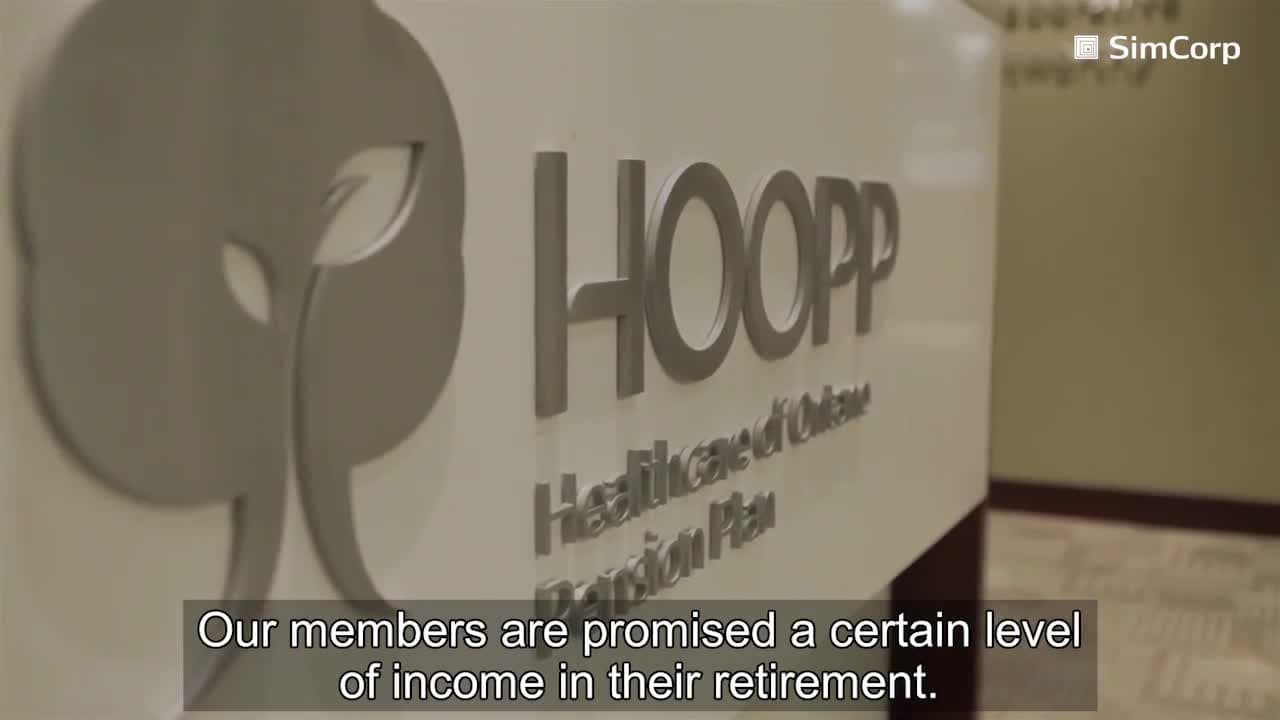

HOOPP
Client story
HOOPP fast tracks derivative processing with advanced portfolio management system
Jim Keohane, former President and CEO of the Healthcare of Ontario Pension Plan (HOOPP), makes the case for an advanced investment management solution to drive derivatives processing and power the liability-driven investment model of the leading Canadian pension fund.
In the constant search for alpha, we see more and more investment management firms including derivatives in their investment programs. Adding these complex instruments to the portfolio puts demands on accounting and settlement processing and presupposes a suitable and sophisticated technology infrastructure to support performance.
The complex nature of derivatives requires technology systems that can support a wider range of asset classes than traditional equity and bond portfolios, with more sophisticated modeling and risk management capabilities. For many investment management firms, this means upgrading their asset portfolio and management technology. However, the individual nature of each business requires a careful choice of system that most closely matches their requirements.
Learn why derivatives processing capabilities were a top priority for HOOPP when selecting an investment management system.

In HOOPP’s case, being a non-profit pension fund with a pledge to deliver our members actively managed assets using a diversified, long-term, and risk-free investment strategy, we required an IT system that better reflected that strategy. What we needed was an advanced system that was capable of supporting the sophisticated program involving derivatives that forms part of our investment strategy.
“What we needed was an advanced system that was capable of supporting the sophisticated program involving derivatives that forms part of our investment strategy.”
Why derivatives processing capability counts
Why derivatives? What makes these instruments so special for HOOPP as a pension plan? Deploying derivatives is not without cost or risk. An investment manager needs expertise and the right technology to deploy derivatives effectively and trouble-free. Derivatives are complex instruments to account and settle for especially in view of the recent regulatory demands we have seen.
At HOOPP, we deploy a wide range of derivatives including futures, options and swaps to generate an excess rate of return on our total investments without taking undue risk. To do this, we need the right investment strategy and the right investment management system acting in tandem.
Perspective on performance
Since its creation in 1960, HOOPP has developed into one of the leading pension funds in Canada. Serving as the main provider of pension services to the Ontario healthcare sector, it has risen to become the largest private pension fund in Canada with assets under management (AuM) totaling almost CAD 60 billion.
Strong double-digit returns propelled HOOPP’s 10-year average rate of return to more than 10%, one of the best long-term records among pension plans worldwide.
Liability-driven model as technology-enhanced investment strategy
Helping to account for this fast-paced performance is the way in which HOOPP structures its investment strategy with technology support. For several years now, HOOPP has implemented a liability-driven investment (LDI) strategy with technology-enhanced derivatives structures playing a pivotal role.
LDI requires modeling of both liabilities and assets, and the matching of cash flows, which in turn require technology support. The liabilities are modeled in terms of calculating what the cash flows look like, what interest-rate sensitivities are built into the liabilities, what inflation-rate sensitivities are involved, and also the demographic profile of our pension membership.
Against this is placed what we describe as a liability-hedge portfolio. One of the main parameters considered in this approach is interest rates: The lower they go, the more they drive up the liabilities – a 0.25 percentage point move in interest rates amounts to a difference of CAD 1-2 billion in shifting valuations.
The benefit of the liability-hedge portfolio is that most of the assets and liabilities move together so that if interest rates go up or down, the assets move accordingly and in tandem.
Return-seeking derivatives portfolio
On top of this, we have what we describe as a return-seeking portfolio, which includes equity overlays, hedges, alpha strategies, various equity-based strategies, private-equity instruments, cross-market arbitrage, etc.
LDI’s basic aim is to match assets with liabilities, to try to ensure we remain fully funded even in periods of market volatility. To achieve that, HOOPP invests heavily in long-dated bonds to make assets match more closely the long-term nature of pension liabilities.
But bonds simply do not earn enough to successfully fund a pension plan like HOOPP in the long term. To earn additional returns in an era of low-bond yields – and to further hedge risks – we also deploy a sophisticated derivatives strategy delivered with leading edge technology, using futures, swaps and other instruments to give the fund extra equity exposure without having to own a large traditional stock portfolio that is vulnerable to market volatility.
The fact that HOOPP is fully funded, at a time when other pension plans are struggling with funding shortfalls, has a lot to do with the decision to adopt the kind of LDI model we have selected.
How derivatives help HOOPP manage risk
The LDI model is hardly risk-free, however. HOOPP’s derivatives portfolio is huge, dwarfing its portfolio of stocks and bonds. Its array of derivatives contracts have a total notional value of around CAD 200 billion, including all the currency hedging and swaps that are layered together to protect its investments.
For HOOPP, derivatives serve as a precision-engineered risk management tool. The use of derivatives allows us to have exposure to risky assets, such as equities, with less risk for the pension fund. If you sell a bond and buy a stock, that’s a level of risk. If you instead use an underlying bond asset to have exposure to a stock, it’s a less risky way of equity exposure than direct ownership.
To this end, we use derivatives to cover our exposures and get a more effective control of risk than we could through a traditional equity and bond portfolio structure.
New system to match new strategy
Helping HOOPP to succeed where other pension plans have failed was the decision in 2004 to on-board a new state-of-the-art investment management system. The decision was based on the aim to reduce portfolio management risk and power the derivatives processing on which implementation of a successful derivatives strategy is based.
At a time when HOOPP was increasingly moving into derivatives and other alternative portfolio compositions, we were using an old legacy IT system as our core operational platform. We found ourselves in a situation where, with business processes increasingly dominated by the use of derivatives, the system was just not capable of keeping up with the growing complexity of derivatives portfolio structures.
Consequently, we were ending up with hundreds of spreadsheets, controlling and risk-managing them, and involving time-consuming and costly workarounds. These error-prone and risky manual processes were no longer acceptable, as in our business errors can translate into heavy losses.
It became increasingly clear to us that the existing portfolio management and accounting system would not support the types of activities we wished to undertake going forward. What we needed was a portfolio management and accounting system that could handle all the various investment products we wanted to employ.
This requirement led us to start a search to replace our legacy system with a solution that could deliver our complex strategy without a lot of manual workarounds and enabling us to obtain more flexibility and functionality in the type of products our investment team handles. A staff of about 40 runs hedge-fund strategies, such as equity long-short, credit long-short, and index arbitrage, all of which generate a significant part of our return stream.
Because of its ability to support the investment team with a fully integrated, front-to-back office architecture with robust capabilities including derivatives processing, management and accounting, we chose to deploy the SimCorp Dimension investment management solution.
“What we needed was a portfolio management and accounting system that could handle all the various investment products we wanted to employ.”
Single integrated system of choice
Supporting diverse investment instruments and strategies requires a robust and flexible investment management system infrastructure. Adopting the new system has allowed the investment team to engage in more and different types of transactions and stress-test the functionality.
Running a sophisticated portfolio made it a high priority to find and deploy a single solution that could support the operation. The investment management system is the primary means of processing every transaction on the books and serves as the pension plan’s investment book of record (IBOR).
It is able to support the complex derivatives book, all existing instruments as well as potential ones to come in the future. All instruments are processed through the system, including bonds, equities, and derivatives. As such, it acts as the single, integrated system of choice to support our investment strategy.
Choosing the new solution was a strategic decision to support the investment team, which manages all the pension plan’s assets in-house. It would without doubt have been very difficult for us to do this effectively without the power, functionality, and flexibility engendered in a state-of-the-art system like the one we are running on now.
The highly integrated and automated investment workflow is anchored in an integrated platform, which allows us not only to reduce manual involvement, but also to further increase workflow integration and automation.
With regard to managing risk, the solution helps us with sophisticated modules to run daily risk reports reviewing exposure to credit, liquidity, and counterparty credit. Specific risk controls around each of the investment strategies are in place in terms of limits, and these are monitored on a daily basis.
For example, the system’s advanced collateral-management module allows us to send and receive collateral to reduce counterparty credit exposure, and on a daily basis we mark all our derivatives to market. With this two-way process, our daily exposure is reduced to essentially zero.
Right state-of-the-art system behind success
The implementation of an LDI strategy at HOOPP reflects success in every respect. The plan stands today in its strongest position ever: It has more AuM and more members than at any time in its history. SimCorp’s state-of-the-art system enables us to mitigate operational and financial risk in our derivatives processing. At the same time, it provides us with a solution to support and empower our investment growth strategy.
By using SimCorp Dimension, our investment team is able to respond more swiftly to changing market conditions and come up with fresh investment ideas, thereby giving us the technology platform to deliver our LDI strategy. This gives HOOPP the speed and flexibility it needs to stay ahead and yet maintain a solid and grounded risk-control culture.
Early on, we realized that an outdated processing and accounting system would stand in the way of derivatives portfolios growth and impede the investment strategy we wanted to adopt. Partnering a solid investment strategy such as we pursue with a superior technological platform helps ensure that the pension pledge we have made to HOOPP’s membership can be met – smoothly, safely, and successfully.
Quick facts
Name: Healthcare of Ontario Pension Plan
(HOOPP)
Headquarters: Ontario, Canada
Industry: Public Pension
Fund (PPF)
AUM: CAD 60
billion
Established: 1960
Website: www.hoopp.com
About HOOPP
Created in 1960, the Healthcare of Ontario Pension Plan (HOOPP) is the pension plan of choice for Ontario's hospital and community-based healthcare sector with over 470 participating employers and approximately 295,000 plan members and retirees. HOOPP invests the net assets of its $60.8 billion fund and administers the Plan. In 2014, HOOPP also paid approximately $1.7 billion per year in pension benefits. The HOOPP defined benefit plan is a formula based benefit that provides security and peace of mind to Ontario's healthcare workforce.
As a defined benefit plan, HOOPP provides eligible members with a retirement income based on a formula that takes into account a member's best five consecutive years of earnings and length of service in the Plan. Once eligible members start receiving a pension, they receive it for life. HOOPP's assets are actively managed using a diversified, long-term investment strategy.